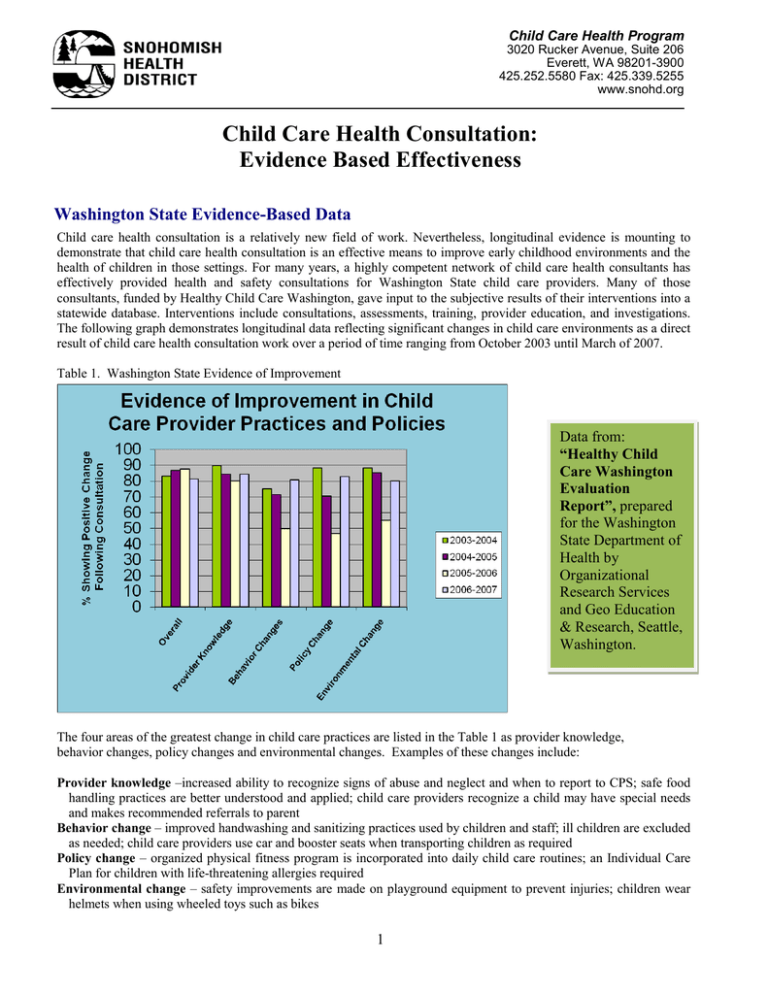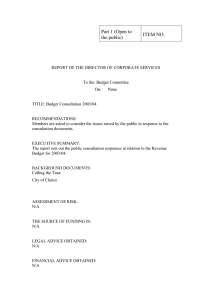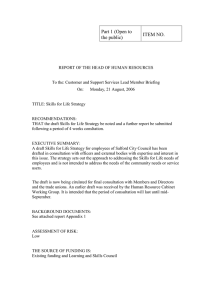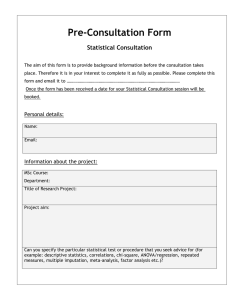Child Care Health Consultation: Evidence Based Effectiveness
advertisement

Child Care Health Program 3020 Rucker Avenue, Suite 206 Everett, WA 98201-3900 425.252.5580 Fax: 425.339.5255 www.snohd.org C Child Care Health Consultation: Evidence Based Effectiveness Washington State Evidence-Based Data Child care health consultation is a relatively new field of work. Nevertheless, longitudinal evidence is mounting to demonstrate that child care health consultation is an effective means to improve early childhood environments and the health of children in those settings. For many years, a highly competent network of child care health consultants has effectively provided health and safety consultations for Washington State child care providers. Many of those consultants, funded by Healthy Child Care Washington, gave input to the subjective results of their interventions into a statewide database. Interventions include consultations, assessments, training, provider education, and investigations. The following graph demonstrates longitudinal data reflecting significant changes in child care environments as a direct result of child care health consultation work over a period of time ranging from October 2003 until March of 2007. Table 1. Washington State Evidence of Improvement Data from: “Healthy Child Care Washington Evaluation Report”, prepared for the Washington State Department of Health by Organizational Research Services and Geo Education & Research, Seattle, Washington. The four areas of the greatest change in child care practices are listed in the Table 1 as provider knowledge, behavior changes, policy changes and environmental changes. Examples of these changes include: Provider knowledge –increased ability to recognize signs of abuse and neglect and when to report to CPS; safe food handling practices are better understood and applied; child care providers recognize a child may have special needs and makes recommended referrals to parent Behavior change – improved handwashing and sanitizing practices used by children and staff; ill children are excluded as needed; child care providers use car and booster seats when transporting children as required Policy change – organized physical fitness program is incorporated into daily child care routines; an Individual Care Plan for children with life-threatening allergies required Environmental change – safety improvements are made on playground equipment to prevent injuries; children wear helmets when using wheeled toys such as bikes 1 Child Care Health Consultation is Population Based Child care environments present incredible opportunities to improve health outcomes for large numbers of children at a time, the primary goal for population based public health. The Snohomish Health District’s Child Care Health Program (CCHP) uses the equivalent of 5.7 full time staff to affect positive health and safety behavior change to approximately 1,000 Snohomish County child care providers. These providers in turn apply their positive health and safety behaviors daily as they care for about 21,000 of our county’s most vulnerable populations, children from 0-8 years of age. Snohomish County Evidence-Based Data CCHP evaluation demonstrates comparable results as those shown in the evidenced-based longitudinal studies of Healthy Child Care Washington (of which the Child Care Health Program participated). From October 1999 until March 2001, child cares in Snohomish County were enrolled in a demonstration project to determine the effectiveness of health consultation activities. A comprehensive assessment tool was used at the beginning and again at the end of the project, with monthly health consultations provided on various topics between the beginning and ending assessments. Data from this project demonstrated that 94% of participating child cares showed improvement in health and safety practices and in the child care environment following CCHP health consultation interactions. The greatest improvement noted in child care provider practices as a result of working with CCHP staff occurred in sanitation, followed by playground safety. Child care providers also improved markedly in the areas of health and illness, medication management, and emergency preparedness. Table 2. Snohomish County Evidence of Improvement 94% of participating child cares showed improvement in health and safety practices and the child care environment following health consultation visits. CCHP provides evidencebased public health services to large groups of children. These services improve the overall quality of care, reduce illness, and increase school readiness for Snohomish County children. 2 National Evidence-Based Data The following is a sample of national studies available that provide evidence that child care health consultation is effective in creating positive health and safety change in child care environments: (Longitudinal Data) “Evaluation of the Child Care Health Consultation Demonstration Program: Phase IV Final Report”, Prepared for Oregon Department of Human Services Office of Family Health, Portland, Oregon, prepared by Pacific Research and Evaluation, LLC, November 2007. Oregon Child Care Health Consultants provide on-site consultations and assessments over a period of four resulting in longitudinal data. Child care records and policies were reviewed and assistance was provided. Documented health and safety improvements ranged from 2% - 60% in the areas of health exclusions, handwashing, emergency plans, and guidance and behavior. 27% ↑ of infant feeding safety practices 24% ↓ in infants with soft bedding 28% ↑ in safe chemical storage 40% ↑ in proper medication documentation 41% ↑ in care plans for children with special needs 38% ↑ in sanitizing food prep areas 30% ↑ in back-to-sleep SIDS prevention practices Cole, PS. 2008, “Child Care Health Consultation Improves Health and Safety Practices and Environments in Early Education Settings”, Indiana Institute on Disability and Community. Moon R and Oden R. “Back to Sleep: Can We Influence Child Care Providers.” PEDIATRICS, 2005, 112(4): 878882. Carabin et al. 1999.“Effectiveness of a Training Program in Reducing Infections in Toddlers Attending Day Care Centers”. Epidemiology 10:3 219-227. 25% ↓ in upper respiratory tract infections 37% ↓ in diarrheal illnesses 17% ↓ in respiratory infections Roberts, Smith, Jorm, Patel, Douglas, and McGilchrist, “Effect of Infection Control Measures on the Frequency of Upper Respiratory Infection in Child Care: A Randomized, Controlled Study”, PEDIATRICS Vol. 105 No. 4 April 2000, pp. 738-742. Roberts, Smith, Jorm, Patel, Douglas, and McGilchrist, “Effect of Infection Control Measures on the Frequency of Diarrheal Episodes in Child Care: A Randomized, Controlled Study”, PEDIATRICS Vol. 105 No. 4 April 2000, pp. 743-746. Alkon and Bernzweig 2008, “Child Care Health Linkages Project Evaluation Summary” & “Child Care Health Consultation Programs in California: Models, Services, and Facilitators”, Public Health Nursing 25:2, 126-139. 66% ↓ in diarrheal episodes 15% ↑ in infants and toddlers with up-to-date immunizations 6.4% ↑ in preschool aged children with up-to-date immunizations Conclusion Due to the reporting efforts of Healthy Child Care Washington and the Oregon Department of Human Services longitudinal data demonstrating the effectiveness of child care health consultation exists and is readily available. CCHP has also demonstrated its effectiveness. National data also exists on the effectiveness of child care health consultation in child care environments as noted above. Child care health consultation is a population and evidence based public health service that is essential for healthy communities and families. Child care environments serve as ideal settings to teach children about healthy behaviors that will help them lead healthier lives. Examples include healthy eating behaviors, preventing obesity, physical activity, handwashing, and how to prevent injuries. The positive impact of child care health consultation with children, child care providers, and families is significant. Not only is child care health consultation evidence and population based, it is also a significant avenue to promote a vast array of public health messages and behaviors. 3





